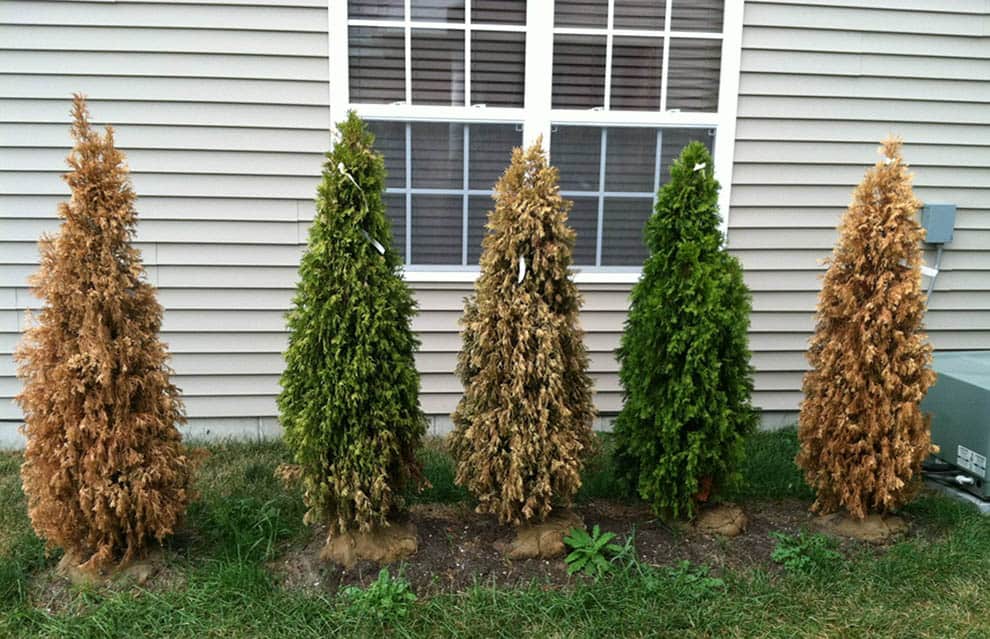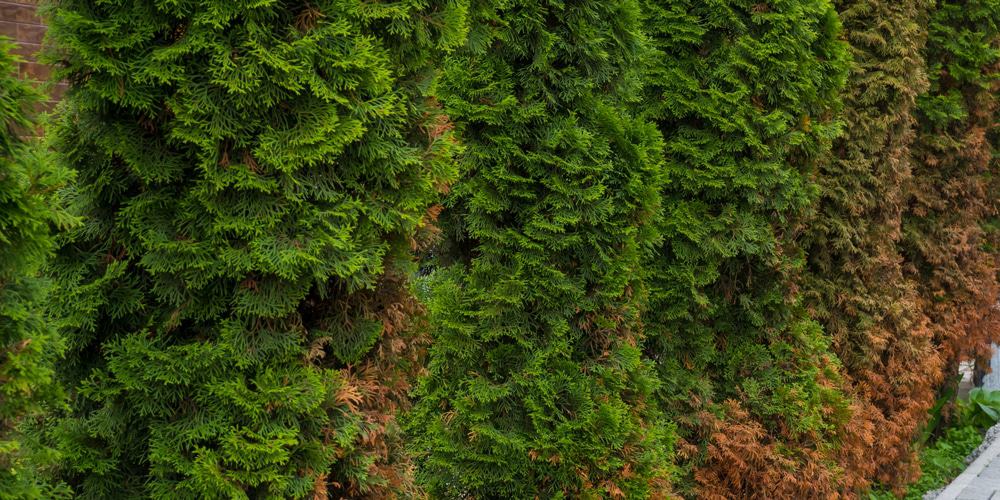Arborvitae is a species of conifer in the family Cupressaceae and a member of the genus Thuja. This plant is extremely popular to plant in front of the house because of its beauty like Christmas trees. In particular, you can also easily trim the appearance of the Arborvitae to the shape you love.
Green giant arborvitae will usually be pale green or yellow when you first plant them. During the fall or winter months, the leaves of Arborvitae can turn yellow and drop leaves. However, they will regain their green color and vibrant beauty once the growing season begins.
If the leaves of Arborvitae plants show signs of turning yellow suddenly and out of season, you need to look into the causes of this condition. Arborvitae turning yellow is associated with a variety of factors ranging from improper watering, pests, lack of nutrients, transplants, fungal diseases, or insect infestations. How to prevent and overcome this situation? Let’s find out the details in the article below.
Arborvitae Turning Yellow: What Is The Reason?
If you notice that the leaves of your Arborvitae plants suddenly turn yellow, followed by brown patches, then you need to find the cause quickly to fix it. Emerald-green arborvitae plants turning yellow are associated with various causes. Here are some of the basic causes that cause the leaves of Arborvitae plants to turn yellow.
Improper Watering
The leading cause of Arborvitae turning yellow leaves has to do with watering. Improper watering will cause plants to have many serious health problems. In particular, watering is of great significance during the seedling stage of this plant.
Newly planted Arborvitae usually need a lot of water to stimulate the growth of the root system and cells. Watering too little or too much water also causes the leaves of this plant to turn yellow or brown in bulk. Overwatering will cause waterlogging of plants while the soil is already saturated and poorly drained. Overwatering can cause root rot, so the plant will receive too much water causing the cells to swell and droop. Rotten root systems also create favorable conditions for harmful fungi and bacteria to attack the entire plant. From there, the leaves will not be able to photosynthesize and maintain the green color from the chlorophyll in the leaves.
On the other hand, emerald green Arborvitae turning yellow after planting can also be due to lack of water. Too little watering will cause the leaves of plants to turn yellow or brown from sun exposure. Cells that do not receive enough water will deform, dry out, and lead to leaf roll-in.
Solution to fix
Determining the cause of the leaves of Arborvitae plants turning yellow is due to lack of water or waterlogging. If waterlogging occurs, you will notice that the ground is wet and has a foul odor. Use a soil moisture meter or finger to test soil moisture from 2-3 inches.
Adequately water plants during high-temperature days and periods of drought. Because most species of Arborvitae plants need a lot of water in the summer. You should water an inch of water per week for plants to ensure enough water for growth.
If you determine the cause is waterlogging, stop watering immediately. Find a way to drain the water by opening up the surrounding soil to let the water out. Add more soil or straw to absorb excess water in the soil. Expose plants to the sun regularly to avoid waterlogging.

Destructive Pests
Thuja green giant is a plant that is resistant to pests and diseases and thrives in harsh conditions. However, Arborvitae plants will still be attacked by some pests and diseases causing the leaves of the plant to turn yellow or brown. Pests and harmful bacteria frequently cause Phytophthora disease. It is a disease that rots the roots of plants and attacks the entire leaves and stems, causing them to slowly die.
Pests can take advantage of open wounds caused by pruning or mining to attack plants. They will find a way to get inside the trunk to suck the sap and cause the entire leaves and stem to turn yellow. These pests and insects can hide in the leaves and grow quickly.
Cypress tipminers are common pests of Arborvitae plants. They often hide on the leaves and branches, making it difficult for the human eye to detect them. The larvae will chew the leaves and suck the sap, from which the leaves will turn yellow or brown due to infection.
Solution to fix
To eliminate and prevent insects and pests, you can use neem oil to spray or clean daily. If Arborvitae plants are severely infected, you need to spray neem oil several times a day and for long periods of time to get rid of the pests. In addition, you also need to clean the entire plant regularly to remove eggs and larvae attached to the leaves.
If the infection level of Arborvitae plants is extremely serious, you should use special drugs to handle it. You need to treat diseases quickly before they spread to the entire plant and kill the root system of the plant.
Lack Of Nutrients
Lack of nutrients is also one of the reasons why arborvitae plants turn yellow or brown. Any plant needs nutrients to grow, especially during the growing season. Emerald-green arborvitae turning yellow is caused by a lack of nitrogen in the soil. Nitrogen works to maintain the green color of the leaves and the health of the plants.
In addition, iron deficiency also causes the leaves of plants to turn yellow or brown. You can use specialized sprays to supplement iron for plants. The young leaves and tops of plants are the earliest affected parts in the form of chlorosis. Therefore, you need to add fertilizers rich in nitrogen, phosphorus, iron, and potassium to maintain the green color of plants. In addition, you also need to pay attention to the pH of the soil, maintaining the pH at an ideal level will help plants absorb nutrients better.
Solution to fix
You should fertilize Arborvitae plants once a year. A type of fertilizer is rich in nitrogen, phosphorus, iron, potassium, and zinc to promote plant growth. The best time to fertilize is in the spring, as soon as the Arborvitae plants begin to produce new leaves and new tops.
You can also use organic fertilizers such as chicken manure, duck manure, blood meals, grass clippings, and leaf debris to make manure. Fertilize around the plant’s roots and up to 3 feet away from the stem. You should use liquid, granular, or slow-release fertilizers to maintain a steady source of nutrients in the soil. In particular, you should not abuse fertilizer to stimulate plant growth. Too much fertilizer will cause the plants to overstress, burn leaves, and slowly die.

Excessive Stress From Transplanting Or Wrong Planting
If you have recently transplanted or planted young arborvitae, it is normal for the leaves to turn yellow or brown. This is due to the sudden environmental change that puts the plants under excessive stress. The root system has not had time to attach to the soil to adapt and transport nutrients, water, and necessary substances to other parts.
If you notice only a few spots or leaf spots are turning yellow or brown, you need not worry too much. As long as the other branches and leaves are still green after a few days of transplanting, the plants will grow back.
Newly planted green giant arborvitae can also have yellow leaves due to improper planting. Planting roots too deep or too shallow will also affect plant growth. If you plant too shallow, the root system will not be able to absorb enough water and nutrients for the entire leaves and stem. Meanwhile, a set of roots planted too deep in the ground can not help plants grow healthy. Regardless of the size of the emerald green arborvitae, you need to dig the hole size or choose the right pot.
Solution to fix
Whenever you change to a new environment for the green giant arborvitae, you need to give the plants time to get used to and acclimatize. This adaptation includes soil environment, soil quality, water, climate, temperature, and sunshine. If you are planting young plants, plant in a cool and warm time. You also need to avoid direct sunlight and water properly.
If you do a thuja green giant transplant, choose the right time, a healthy branch, and fertilize to promote plant health. Use a canopy to avoid the sun, strong wind, or heavy rain to protect plants in the early days of transplant. After the root system is firmly attached to the soil, plants can grow and develop rapidly.
Destructive Animals
Green giant arborvitae turning yellow can also be associated with animal infestation. The urine of animals such as dogs, cats, or squirrels can also cause the leaves of the Thuja green giant to turn yellow or brown. This is because animal urine can change the nitrogen levels in the soil. If the urine volume is large and accumulates over time, plants can be severely affected. Therefore, when there is a lack of nitrogen in the soil, the leaves of green giant arborvitae will turn yellow or brown.
Solution to fix
Protect the base of arborvitae plants by mulching with straw, coconut shells, or dried leaves to keep out animal urine. Plus, you also prevent dogs, cats, or other animals from urinating around the base of the tree. If you find too much animal urine, rinse the soil with strong water or replace it with a new soil mix.
Fungal Diseases
Fungal diseases also cause the leaves of emerald-green arborvitae to turn yellow or brown. Pestalotiopsis leaf blight or leaf spot diseases are also caused by harmful fungi and bacteria. Fungal diseases are difficult to treat and take a long time. Therefore, when you find that the plant has been infected, you should cut off the diseased parts to avoid spreading to other parts.
If the plant has a very severe fungal infection, you should prune all diseased branches to avoid spreading the disease to the trunk. Keep the stem healthy so that it can revive the next growing season.
Solution to fix
You should regularly check and clean the leaves. The airborne fungal spores will attach to the leaves of arborvitae plants under favorable conditions. The most ideal growth environment for mushrooms is wet and waterlogged. Therefore, you should not water plants at night to avoid water wetting the foliage. In addition, you also need to water properly to avoid waterlogging. Prune infected branches to prevent the fungus from spreading to the entire plant.
Conclude
Arborvitae turning yellow has a lot to do with different causes. Some common causes include under-watering or over-watering, nutrient deficiencies, insect infestations, nutrient deficiencies or over-fertilization, excessive stress from improper planting or transplanting, animal infestations, or fungal diseases.
To prevent these diseases, you need to regularly observe the early signs to determine the cause and how to fix it. Water it properly, supplement nutrients with organic or chemical fertilizers, and use neem oil as a natural insecticide to get rid of insects. Also, beware of fungal diseases and animal infestations in your garden.